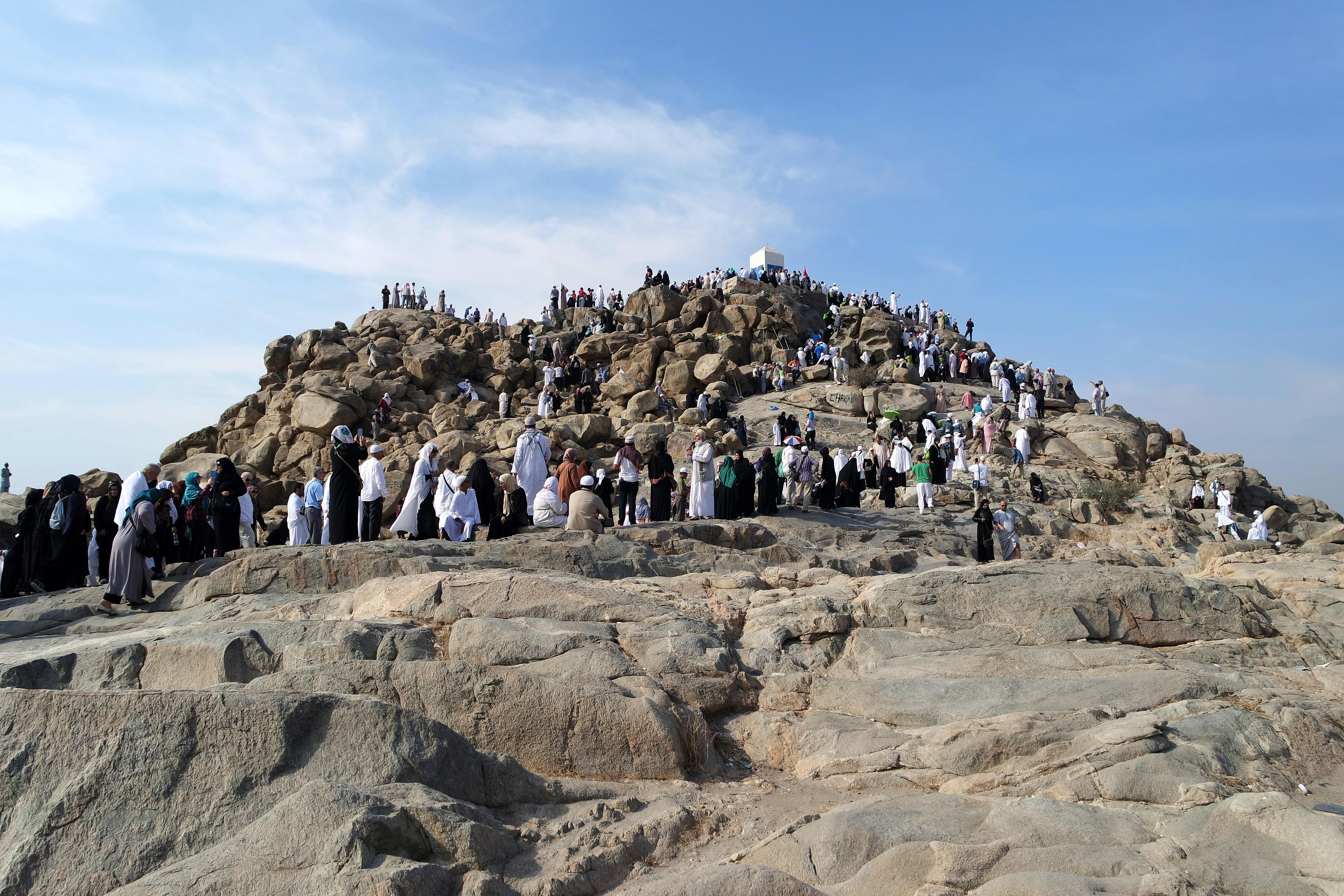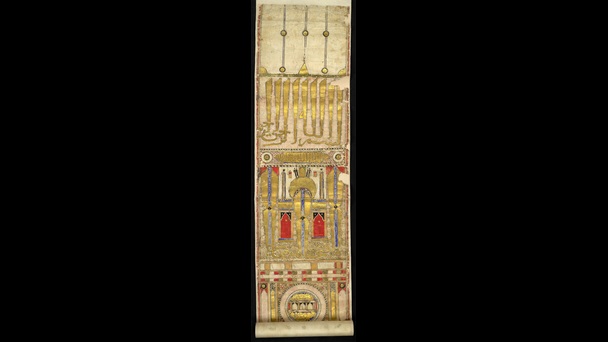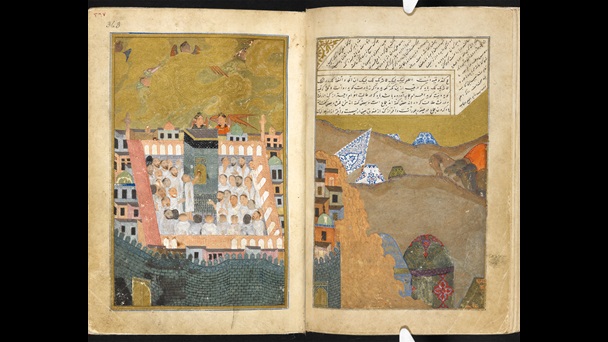Find out more about The Open University's Religious Studies qualifications.
Eid al-Adha means feast or festival of the sacrifice. It is also known as Eid al-Kabir (the great feast) and by other names in different countries, such as Qurban Bayrami in Türkiye. It begins on the tenth day of Dhu al-Hijja, the last month of the Muslim calendar, and can last up to four days, and because this calendar is a lunar one, it takes place around eleven days earlier each year. It is linked with a pilgrimage to the city of Mecca in Saudi Arabia known as the Hajj (a word meaning ‘to set out with a specific aim or purpose’) and the rituals performed during this.
 Pilgrims standing on Mount Arafat on the outskirts of Mecca as part of the Hajj pilgrimage.
Pilgrims standing on Mount Arafat on the outskirts of Mecca as part of the Hajj pilgrimage.
On the tenth day of Dhu al-Hijja, Muslims around the world will join a special congregational prayer performed in a mosque or prayer ground and listen to a sermon. After that they may visit the graves of family members and then gather with friends and relatives to give each other gifts and to enjoy a meal together (and they may exchange special greetings cards). As well as an opportunity for prayer and rejoicing, Eid al-Adha is time for gratitude when people will thank God for all the blessings they have received. It is a time for generosity too, and Muslims are encouraged to make charitable donations during it.
This charity usually consists of a gift of meat because one of the important features of this Eid has traditionally been a sacrifice. Those who could afford it sacrificed a sheep, goat, cow or camel, and divided the meat into three parts, keeping one part for themselves and giving a third to the poor and a third to neighbours. The animal had to be healthy and fully-grown and slaughtered according to strict rules. Nowadays Muslims living in countries where animals can only be slaughtered in abattoirs often pay the value of an animal to Islamic charities – for example Islamic Relief or Penny Appeal. These charities arrange for animals to be sacrificed in the country of the donor’s choice and distribute the meat to the poor.
 This 15th-century scroll commemorates the hajj by a woman called Maymunah. Seen here, reading downwards, are: the sanctuary of the Ka’bah at Mecca, the hill al-Marwah, the shrine of the Prophet and the Prophet's sandal.
This 15th-century scroll commemorates the hajj by a woman called Maymunah. Seen here, reading downwards, are: the sanctuary of the Ka’bah at Mecca, the hill al-Marwah, the shrine of the Prophet and the Prophet's sandal.
This sacrifice recalls an important event in the life of the prophet Abraham (a major figure in Muslim, Jewish and Christian traditions). Though their accounts are not identical, the Qur’an and the Hebrew Bible (the Christian Old Testament) agree that God tested Abraham’s faith by demanding that he sacrifice one of his sons (Muslims usually understand this son to have been Ismail, not Isaac as in the account in Genesis). According to Muslim tradition Satan tried three times to persuade Abraham not to obey God’s order, and the angel Jibril (Gabriel) told Abraham to throw pebbles at Satan to drive him away. In the end, however, God provided Abraham with a ram to slaughter instead. The Eid al-Adha sacrifice therefore commemorates Abraham’s obedience to God’s will.
Abraham and Ismail are believed to have built (or rebuilt) the Ka’ba, referred to in the Qur’an as ‘the House’, a cube-shaped structure covered in black velvet cloth, situated in the Great Mosque in Mecca in Saudi Arabia, and encouraged people to visit it. Nowadays Muslims may visit the Great Mosque at any time of the year. The Hajj pilgrimage, however, can only be performed from the seventh to the twelfth of Dhu al-Hijja. It is regarded as one of the five central Muslim acts of worship or devotion, sometimes referred to as pillars, and every Muslim (Sunni and Shi’a) who is in a position to do so should try and perform it at least once in their lives. It combines visiting the Great Mosque with the performance of a sequence of additional rituals outside Mecca. Some of these are quite complicated, and it is only possible to touch on the really central ones here (for more details see e.g. Hajj guide: step by step guide to performing).
 A Timurid painting of Mecca, depicting the pilgrims camping outside and making preparations.
A Timurid painting of Mecca, depicting the pilgrims camping outside and making preparations.
Outside Mecca men must put on special clothing; women must dress modestly, covering their hair and their bodies apart from their hands and feet. They begin by visiting the Great Mosque and walking seven times anti-clockwise around the Ka’ba. Particularly important is what is called the ‘standing’. This is performed on the ninth day of Dhu al-Hijja when pilgrims stay from noon until sunset on the plain of Arafa some miles outside Mecca, praying and asking God to forgive their sins and those of all Muslims and listen to a sermon. On the tenth day, together with Muslims round the world, pilgrims sacrifice an animal or have one sacrificed on their behalf, and cook and eat some of it. It is impossible for the pilgrims to consume all the meat from sacrificed animals, and the surplus is refrigerated and distributed to the poor by relief organisations. Another key ritual involves stoning a pillar once and later it and two other pillars twice, recalling Abraham’s throwing pebbles at Satan. It also represents the rejection of selfish wishes and desires. After the final stoning pilgrims make a last visit to the Ka’ba to complete the rituals.
In the past the Hajj pilgrimage often involved an arduous and dangerous journey. It remains a challenge because of the huge numbers of pilgrims who normally perform it, reaching a peak of more than three million in 2012 (though they declined dramatically during 2020 and 2021 owing to the pandemic). This year there has been some controversy in the UK because the Saudi government has reduced the numbers of places available to British pilgrims. The Hajj continues to be a deeply moving experience that makes a profound impression, and the fact that pilgrims and non-pilgrims both share the sacrificial feast on Eid al-Adha helps to create a sense of community between them all.







Rate and Review
Rate this article
Review this article
Log into OpenLearn to leave reviews and join in the conversation.
Article reviews